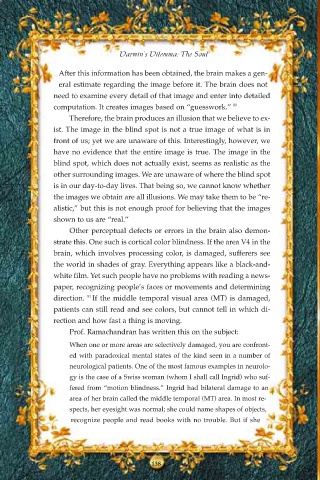Page 140 - Darwin's Dilemma: The Soul
P. 140
Darwin’s Dilemma: The Soul
After this information has been obtained, the brain makes a gen-
eral estimate regarding the image before it. The brain does not
need to examine every detail of that image and enter into detailed
computation. It creates images based on “guesswork.” 80
Therefore, the brain produces an illusion that we believe to ex-
ist. The image in the blind spot is not a true image of what is in
front of us; yet we are unaware of this. Interestingly, however, we
have no evidence that the entire image is true. The image in the
blind spot, which does not actually exist, seems as realistic as the
other surrounding images. We are unaware of where the blind spot
is in our day-to-day lives. That being so, we cannot know whether
the images we obtain are all illusions. We may take them to be “re-
alistic,” but this is not enough proof for believing that the images
shown to us are “real.”
Other perceptual defects or errors in the brain also demon-
strate this. One such is cortical color blindness. If the area V4 in the
brain, which involves processing color, is damaged, sufferers see
the world in shades of gray. Everything appears like a black-and-
white film. Yet such people have no problems with reading a news-
paper, recognizing people’s faces or movements and determining
direction. If the middle temporal visual area (MT) is damaged,
81
patients can still read and see colors, but cannot tell in which di-
rection and how fast a thing is moving.
Prof. Ramachandran has written this on the subject:
When one or more areas are selectively damaged, you are confront-
ed with paradoxical mental states of the kind seen in a number of
neurological patients. One of the most famous examples in neurolo-
gy is the case of a Swiss woman (whom I shall call Ingrid) who suf-
fered from “motion blindness.” Ingrid had bilateral damage to an
area of her brain called the middle temporal (MT) area. In most re-
spects, her eyesight was normal; she could name shapes of objects,
recognize people and read books with no trouble. But if she
138

